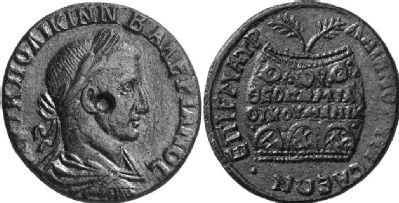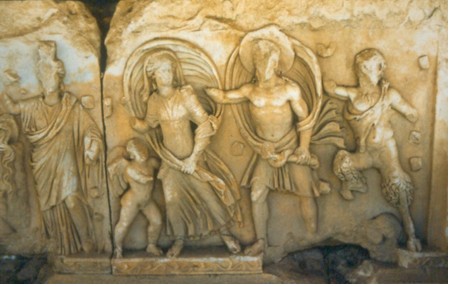All entries for December 2013
December 13, 2013
Roman Numismatic Memory Part 2: Gaius and Lucius as principes iuventutis
 |
| Aureus showing Gaius and Lucius |
The second in our Augustan bimillenium series continues the theme of Roman numismatic memory. One of the key themes of Augustus' principate was the problem of succession, and initially Gaius and Lucius Caesar were advertised on the imperial coinage as Augustus' heirs, as principes iuventutis. Between 2 BC and AD 4 (or perhaps later), the mint at Lugdunum (modern day Lyon) struck aurei and denarii showing the two brothers veiled and accompanied by shields, spears, and priestly symbols (Lactor J58, RIC Augustus 205ff).
That these coins, and the images on them, were viewed by the Romans as 'monuments in miniature' as well as currency, is demonstrated by the later use of this image. During the reign of Trajan a series of coins were struck that modern scholars call the 'restitution' coinage. This was a series of coins that bore the imagery of a much earlier coin type, either from the Republican or early imperial period. These coins celebrated the earlier coinage of the Romans, and Trajan himself is named and honoured as the 'restitutor' (just as an emperor may have been honoured for restoring a building or other monument in Rome). Why these coins were struck, and why particular coins were chosen to be celebrated over others, still remains a mystery to scholars. One of the current ideas is that these coins were struck as the older coinage in circulation was being recalled and melted down. Given the Roman conception of coinage this was a destruction of a monument in miniature, so the 'restitution' series was struck to counter this. Another idea is that the coins may have formed a gift for noble families at the time.
 |
| Restitution coin struck under Trajan (?) |
In this context we should note a 'restitution' coin issue that honours the earlier coin of Augustus showing Gaius and Lucius. The coin in question reproduces Augustus' earlier issue exactly; unlike the other restitution coins of Trajan, he is not named on the coin as restitutor. But Augustus' portrait on the obverse of the coin is of Trajanic or Hadrianic style; this is not an Augustan period coin. Because of Trajan's restoration of other earlier coinages, most scholars place this piece in the reign of Trajan (AD 98-117). What this coin reveals is that Augustus' numismatic imagery was more than just decoration of the currency. The Romans observed, recorded and recalled Augustus' imagery at a later date. Why this particular type was restruck under Trajan remains a mystery, but this, along with the other restitution coinages, would have served to connect the emperor with Rome's past, and its first emperor.
(Coin images reproduced courtesy of Classical Numismatic Group Inc., www.cngcoins.com)
December 01, 2013
A coin of Nysa celebrating the 'Theogamia' or sacred marriage
 |
| Coin of Nysa celebrating the sacred marriage |
My coin of the month comes from Nysa, a city in the Maeander valley in Asia Minor. Minted in the mid-third century AD, it shows the emperor Valerian I on the obverse while the reverse celebrates a festival held in the city, the ‘Theogamia,’ in honour of the ‘Sacred Marriage’ between Pluto and Persephone. The name of the festival is written in Greek letters inside a large prize crown: ΘEOΓAMIA OIKOY MENIK (Theogamia Oikoumenika). Two palms, the symbol of victory, emerge from the top. The epithet Oikoumenika indicates that the festival had been awarded international status, a mark of prestige in the bustling festival culture of the second and third centuries AD, when cities competed to attract performers to their games. Earlier coins do not include this title, and so this new type may have been minted specially to celebrate the new honour, which had to be awarded by the emperor.
The festival celebrates the sacred marriage between Persephone (daughter of the goddess Demeter) and the god of the Underworld, Pluto. Nysa proudly boasted a sanctuary of Pluto and Core (Persephone), as well as a cave thought to provide an entrance directly into the Underworld (Strabo 14.1.44-45). The Rape of Persephone, in which the maiden daughter of the goddess Demeter was seized by the god of the Underworld while she was out picking flowers, was a familiar myth in the ancient world, often used in funerary art as a visual metaphor for untimely death.
 |
| Relief from the theatre at Nysa, showing Pluto’s pursuit of Persephone. |
The people of Nysa, however, put a more positive spin on the myth, and its associations with their territory, featuring it on the reliefs of their theatre as well as on coinage. According to the Homeric Hymn to Demeter (l.17) the abduction took place on the plain of Nysa, allowing the city to lay a strong individual claim to this well-known myth. Rather than stressing the destructive aspects of the myth, however, they asserted instead the importance of the union between Persephone and Pluto, as can be seen in the theatre reliefs, where Pluto is shown pursuing a hesitant Persephone, rather than dragging an unwilling bride into his chariot. Through this public festival they tied a universally-known myth to their particular local territory, asserting both their unique religious identity, and their place in a wider Greek world.
This coin shows the importance cities of the Greek world placed on their festival culture in the high Roman empire: both as a means to assert their local importance (often in rivalry with neighbouring cities), and to show their membership of the broader Hellenic religious community.

Dr Zahra Newby is Reader in Classics and Ancient History. Her research focusses on Roman art in its social context, in particular on Greek festival culture, ancient athletics, and the representation of myth in the Roman empire.
Further reading:
S. Mitchell, ‘Festivals, Games and Civic Life in Roman Asia Minor’ JRS 80 (1990) 183-193
Z. Newby, ‘Art and Identity in Asia Minor’, in S. Scott and J. Webster, (eds.) Roman imperialism and provincial art. (Cambridge, 2003).
S. Price, ‘Festivals and games in the cities of the east during the Roman Empire’, in C. Howgego, V. Heuchert, and A. Burnett eds., Coinage and Identity in the Roman Provinces (Oxford, 2005).
Coin image reproduced from Hack & Aufhauser, Auction 20, lot 490. Photo of theatre relief by Newby.
 Clare Rowan
Clare Rowan

 Please wait - comments are loading
Please wait - comments are loading

 Loading…
Loading…